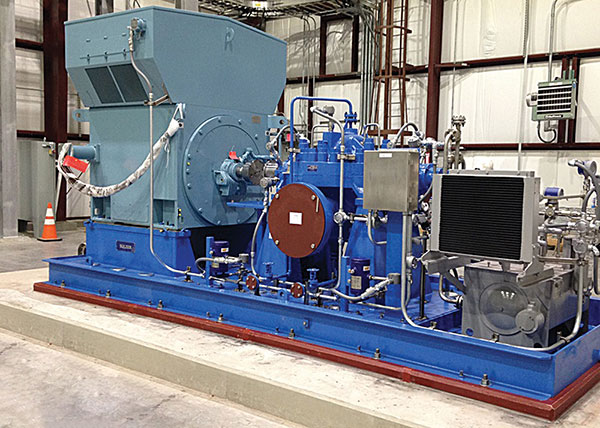October 2018, Vol. 245, No. 10
Tech Notes
Sulzer Installs 15 Pump Skids for Pipeline Conversion Project
Large-scale projects typically involve many stakeholders, contractors and suppliers, which can lead to increased complexity and more challenging situations. Delivering such projects on time and within budget requires considerable coordination and management skills, traits that one U.S. energy company needed in order to complete its most recent expansion project.
The locations of oil deposits are rarely close to a refinery, so it is necessary to use a series of pumping stations to transport the oil from its source to the facility. The objective of this project was to convert an existing gas pipeline into a crude oil pipeline with a pumping capacity of 320,000 bpd of light crude.
Although this is a huge undertaking, the conversion is more cost-efficient and environmentally-friendly than constructing an entirely new pipeline. However, the project required all new pumping equipment to be installed, a task that would demand considerable expertise.
Braving the Elements
The contract to design, manufacture, install and commission 15 pump skids in just 10 months was awarded to Sulzer. Spanning three states, working through the cold, winter months and coordinating with seven different internal and external partners, this project had potential challenges throughout its duration.
The entire project took years of planning and involved the local authorities and the power companies that, in many cases, needed to upgrade the electrical supplies to the pumping stations. These supplies dictate the size of the electric motors that can be used to power the pumps and as such form the starting point for Sulzer, which supplied this equipment.
The logistics required to expand the pumping stations and increase capacity are enormous, but any such project also needs expert design and management skills to be successful.
One of the most important steps in the process was the appointment of the project manager, who would be the single point of contact for the client, in addition to collaborating with the other stakeholders and contractors.
Design
As part of the project, new contracts had to be signed with the energy providers in each state to receive the necessary electrical supplies. These supplies affected the design of the electric motor that was installed with each pump, as well as the performance of the pump.
The pumps for each station were designed based on data provided by the customer. For each location, information relating to the increase in head, pressure, flow, fluid viscosity and temperature dictated the design of each pump.
In this case, the pump designs were based on the HSB horizontal axially split single-stage, double suction pump. This has a proven record of reliability and efficiency in crude oil pipelines around the world.
Capable of pumping up to 45,000 U.S. gallons/min (10,200 m3/hour) at a head up to 1,800 feet (550 meters) and able operate with temperatures up to 400° F (200° C) and pressures up to 2,200 psi (150 bar), the HSB pump is extremely versatile.
Tailored to Application
The pump skids were designed to a typical pipeline configuration but tailored to the customer’s specific requirements, including figures for energy efficiency. In projects of this scale, pump efficiency can be the deciding factor in the operational profit of the pipeline.
“Even small improvements in this figure can have a very significant impact on the running costs of a pumping station,” said Dana Vilsack, project engineer for Sulzer. “Multiplying this across 15 units will offer substantial savings in annual running costs.”
A typical pump in this project required 2,800 hp (2,100 KW) power input to deliver a flow of 9,300 U.S. gallons/min (2,100 m3/hr), with a head of 825 feet (250 meters), depending on the specifications for the pumping station. In each case, the design was scaled and fine-tuned to meet the exact requirements of each location. In this way, the optimum pumping conditions and efficiency could be maintained throughout the pipeline.
The customer understood the complexity of the project and the logistical challenges that it presented. Therefore, to minimize the management burden, the major contractors on the project were chosen for their ability to deliver large sections of the work in-house. In Sulzer’s case, as a turnkey solution provider, it could manage the transport and installation of the pumps, as well as the supply of the electric motors.
“This was one of the most organized and cooperative projects I have been a part of.” Vilsack said.
Turnkey Delivery
The success of the project started at the top with the decision by Sulzer’s project manager to work on-site rather than in one of the remote company offices. In this way he was able to deal directly with all the interested parties and provide a more hands-on management of the project. This also helped to maintain momentum within the project and ensured that all the milestones were met.
The greatest challenge in a project of this scale is the logistical effort required to build and install all the pumps. With so many other contractors involved in the buildings and the installation of the pipework, effective project management was essential for the timely completion of the scheme.
As a project for Sulzer, it involved almost every aspect of their business. From the engineers who designed the new pumps, to the manufacturing sites that produced and tested every pump to the field service teams and electro-mechanical engineers who provided support to the installation teams. P&GJ






Comments